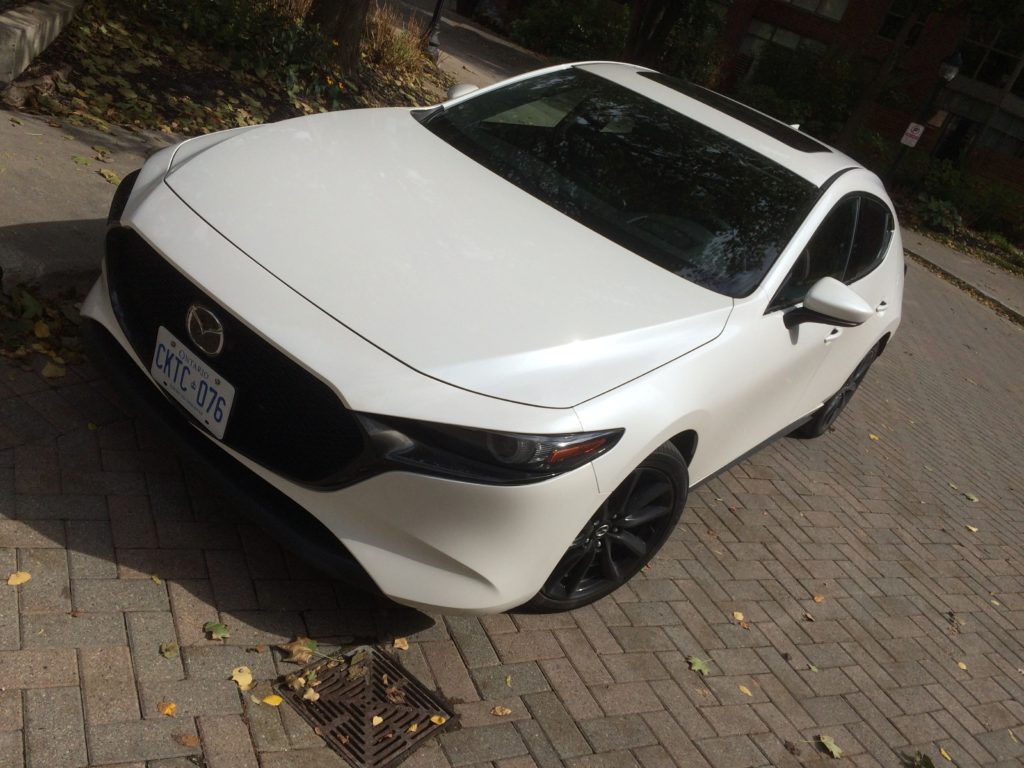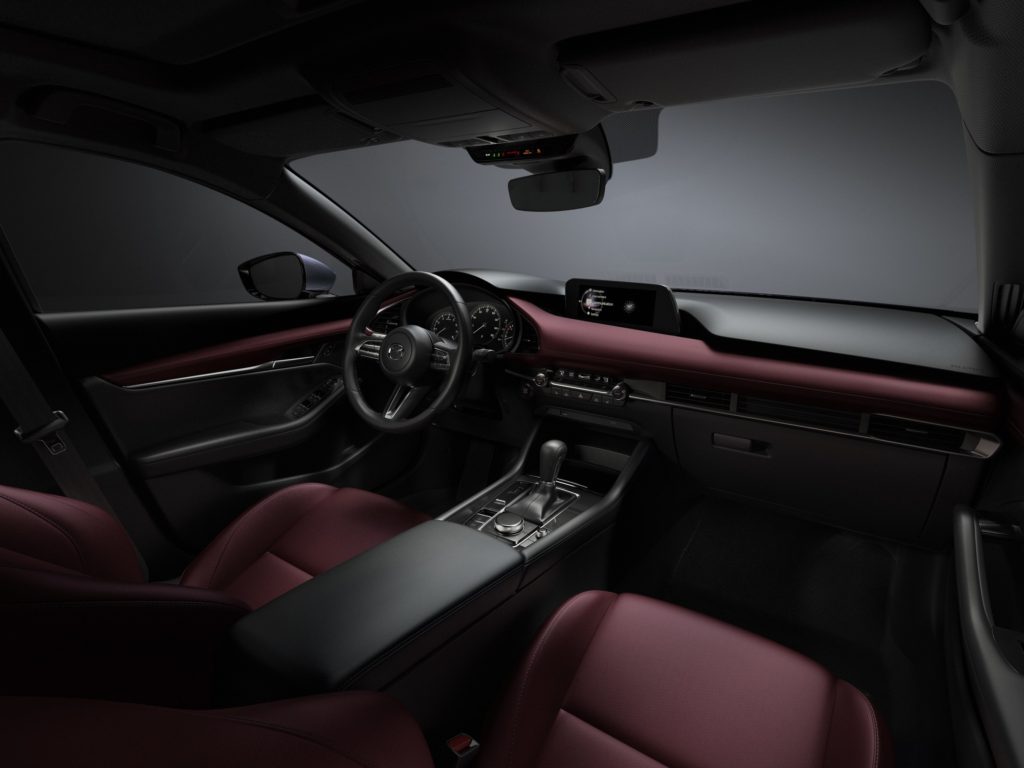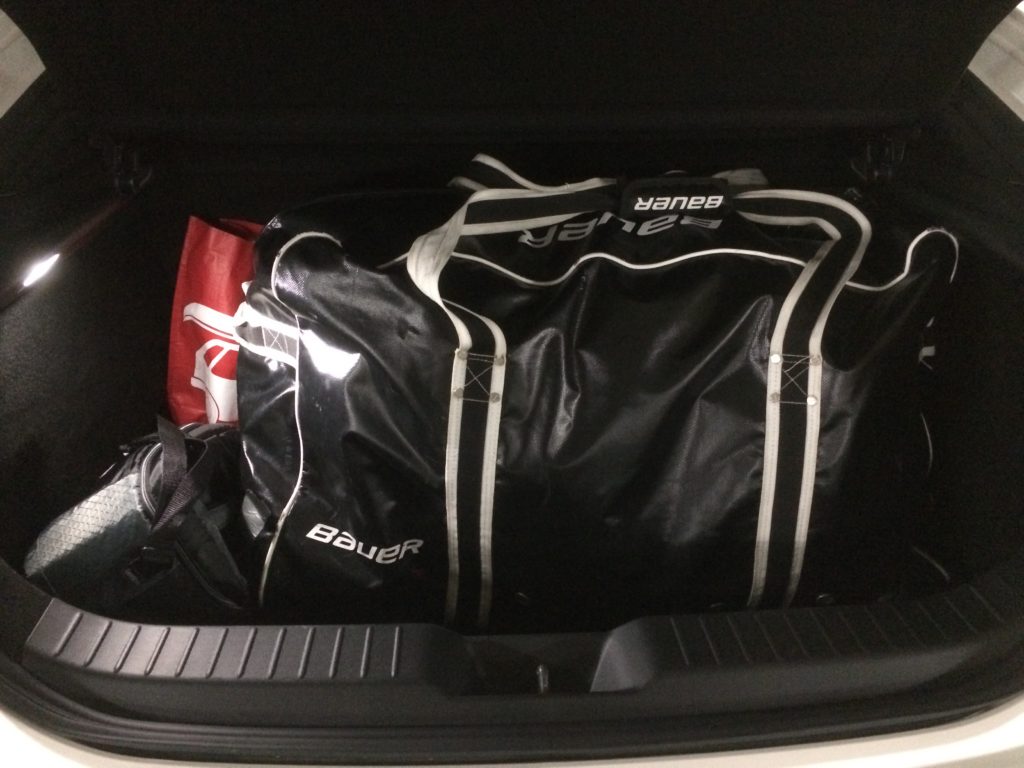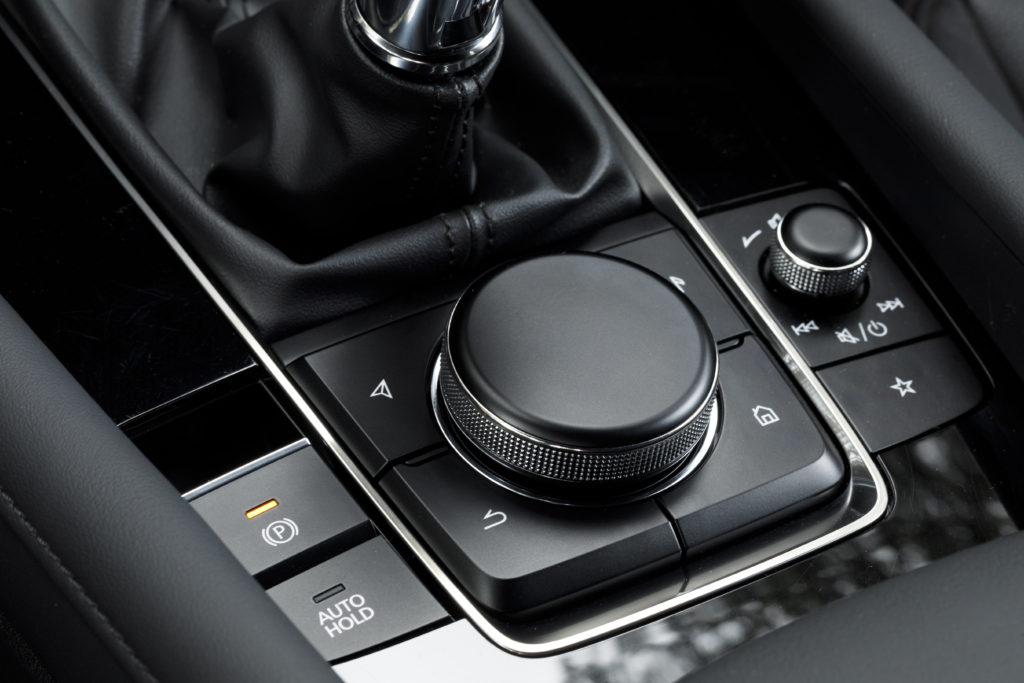My definituion of “business success story” includes companies that punch well above their weight (measured by market share). It also includes automakers whose offerings, while seemingly pedestrian, drive like more expensive vehicles. By both measures, Mazda has been succeeding for years. To keep up with the pack, the Japanese company released the 2020 Mazda3 Sport.

First impressions
My snowflake white pearl tester is a step towards minimalism when compared with the previous Mazda3’s body. Squintier headlights and fewer curves overall give the car a “flatter” appearance, making it a distinct design step away from the previous 3 while retaining details like the wide, grinning front grill and the sloping rear window. (I can say the same things about the Mazda3 compact sedan.) The overall package looks just as sporty as its predecessor.
Interior
Red leather seats welcomed me into the car. I made a few adjustments, and I was quickly off. Small, practical cars that fit people my size (6’5”) aren’t easy to come by, and I appreciated the fit – for the most part. It would have been perfect without the sunroof. I was able to sit up straight, but my head reaches the car’s ceiling at the sunroof’s edge (a common occurrence for me) so I had a new hairstyle each time I stepped out of the car.

Compared to other cars, Mazda interiors tend to be a study in minimalism. Buttons, dials and knobs for climate controls, on the steering wheel and in the infotainment cluster are only what you need, and not more.
When I first saw photos of the new 3, I was concerned about the increased size of the C-pillar. It cuts into both the rear window and the rear seat side windows. The net effect is to increase the size of the blind spot. I noticed this when changing lanes to my right. Fortunately, Mazda includes a blind-spot detection system to mitigate this design choice – more on that below.
The back seat is still unkind to six-footers and above, but the seats offer the same firm, high-quality support that’s found up front.
Hockey bag test
There’s enough room to fit my bag longitudinally in the hatch. This hatch was so deep, the bag did not prop up the privacy cover. I also managed to wedge a backpack beside the bag.

In-cabin technology
Unlike the rest of the car, Mazda’s infotainment system has lagged behind the competition for years. That’s no longer the case. Mazda widened the standard screen to 8.8 inches, simplified the menus and updated the overall look. Apple CarPlay works flawlessly now from either of the two USB ports in the car. Android Auto also comes standard.
The infotainment control cluster also received an update – in configuration. The favorites button moved “below” the on/off/volume knob. The HMI Commander knob/button/joystick is surrounded by four buttons instead of five. The whole cluster is functionally the same. Of note: the widened HMI Commander and the volume knob were redone in a metal pattern that reminds me of the “spike rings” on the sides of turntables that tell you whether the speed of a vinyl record is correct. The look is more subtle on Mazda’s controls, but they do look sharp.

The instrument cluster consists of a middle screen containing a metal ring where the speedometer appears. Mazda places a red indicator for the speed limit at the right notch in the speedomeer, and whenever you pass the speed limit, it uses a red curved line to indicate the gap between your actual speed and the posted limit. Sections of the screen outside the speedometer ring feature current fuel economy and a fuel gauge with estimated range. Flanking the screen to the left is the tachometer and to the right, oil temperature and fuel gauge. Clicking the Info button on the steering wheel doesn’t bring up many extra screens, but then again, that isn’t necessary while driving.
Mazda includes a heads-up display (aka active driving display) with some of this same information. Gone are the screens that flip up from the dash. Mazda has joined the mainstream and now projects the HUD onto the windscreen.
This is a small detail, but I need to mention the fob. It is now a rectangle resembling a piece of chocolate. Tiny buttons sit on the edges of the chocolate instead of the wide surface. Truth be told, you may not need to use the fob. The 3 features advanced keyless entry and ignition. The car audibly locks itself when you walk away from it. A button on the bottom of the hatch lid lets you lock the car before you close the lid. Still, I suspect many people want to continue to use fob buttons. The tiny buttons on this fob may annoy drivers with poor eyesight – at least until they memorise the button layout.
Driving
Mazda has been delivering mass-market vehicles that drive like more expensive models for some time, and the latest Mazda3 is no exception.
Mazda’s SKYACTIV-G 2.5L engine supplies 186 hp and 186 lb-ft of torque to the front wheels, plenty to get the nimble Sport quickly off the line and passing at highway speeds. For the first time, the Mazda3 can be had with all-wheel drive too.
The smooth-shifting SKYACTIV manual six-speed transmission lets you play with the power. (I’m grateful Mazda still offers a manual on the 3. I’m told the capable Mazda6 sedan only ships with an automatic.)
Active safety features include a chime that brought me back decades to when I used to play Mario Brothers video games. That pleasant chime sounded whenever I indicated a lane change while a vehicle was in my blind spot. The Mazda also places icons in the instrument panel display whenever it senses vehicles in a blind spot, so drivers know what’s behind them ahead of time. The package on my tester included exterior mirrors with reverse tilt down function, which also reduced my blind-spot anxieties.
This is the second time I’ve used adaptive cruise control (radar cruise control in Mazda parlance) in a manual transmission car. I can’t say I minded shifting, though the cabin stays so quiet I had to pay more attention to engine noise and occasionally glance at the tachometer. Mazda kept the digital shift indicator which shows both the gear you’re using and, if required, the gear it recommends you use.
Lane-keeping assist features both haptic feedback through the steering wheel and a circular red graphic inside the digital speedometer that tells you to turn the wheel to get back in your lane.
Traction control and dynamic stability control were standard on the Sport I drove, as were Smart City Brake Support and Smart Brake Support Rear. Automatic adaptive lights, the “peek-around-the-corner” system that shines the lights in the direction you’re travelling even when you aren’t moving straight ahead, also ship standard.
Fuel economy
Mazda publishes fuel economy ratings of 9.2 L/100 km in the city and 6.6 L/100 km on the highway. The onboard fuel economy monitor told me that on some highway drives, I managed a smidge over 5 L/100 km, phenomenal numbers for a 2.5L engine. I imagine the 2.0L engine delivers even better mileage for a manageable tradeoff in power. Numbers like these happen thanks to the Mazda deactivating cylinders when the engine is not under stress (for example, under cruise control on a level highway or letting off the accelerator well in advance of a stop).
The Mazda3’s 50L fuel tank takes regular unleaded gas.
Pricing
The 2020 Mazda3 Sport retails for $26,200 MSRP. With options and additional fees, the vehicle I tested came to $30,395 MSRP.